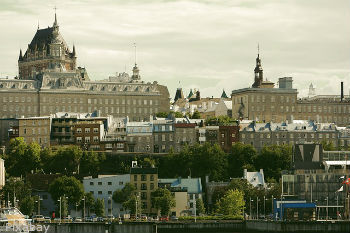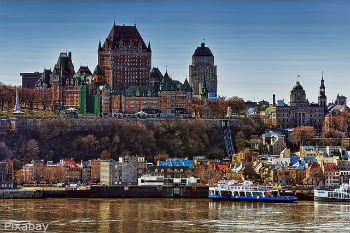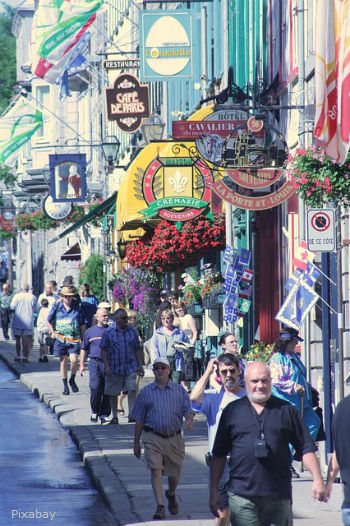The capital of Canada’s eponymous French province, Quebec City gets its name from an Algonquin word meaning “where the river narrows.” It is the vital St. Lawrence River that narrows as it passes through Quebec City. This important location is why the city historically has been so important to Canada--it was even the country's first capital.
Founded in 1608, Quebec City is one of North America’s oldest--Old Quebec’s walls are an official world Heritage Site, according to UNESCO. The capital of French Canada is rife with history, after all.
Quebec’s Climate
Quebec’s climate is “humid continental”, according to the Köppen climate classification system. This means that it has four distinct seasons, with hot summers and cold winters.
The average high in the summer is only 22 to 25 degrees Celsius, yet it seems much hotter due to the high humidity in the river-adjacent city. Still, summers are mild for its classification, with average lows reaching 11 degrees.
Winters, on the other hand, are relatively harsh. The average high during winter months is only -7 degrees Celsius while the average low is -15. Additionally, there are about 316 centimeters of snow each year. Snow tends to be on the ground between December and April.
Neighbourhoods
Quebec has six boroughs broken up into 35 districts, many of which are former towns annexed by the city. As with most city annexations, the former towns maintain some of their old identities.
That said, Quebec is not terribly diverse. Of roughly 532,000 residents, 95 percent of the population are native French speakers. Native English speakers make up only 1.5 percent of the population, so you probably should learn some French before moving to Quebec City.
Most neighbourhoods are also religiously uniform--90 percent of the city is Roman Catholic. There are small Jewish, Protestant, and Muslim communities, however.
Safety is always important, no matter which neighbourhood you choose in Quebec. The city has one of the lowest crime rates in Canada--between 2006 and 2008 it went over a year without a single homicide. That’s no small feat for a fully populated city.

Registering Your Vehicle in Quebec
If you are bringing your car into Quebec, you need to get it registered. The province of Quebec does not operate under the same rules as most of Canada, so research the registration requirements. Head to
Quebec’s Auto Insurance Website to get details regarding registering vehicles in Quebec.
TIP: Quebec usually allows you six months to drive with a license from a foreign jurisdiction before you must get a Quebec license.
Quebec City's Schools
Quebec’s public school system is governed by the Ministry of Education, Recreation and Sports. They run most of the city's elementary and secondary educational institutions.
The most noteworthy university in the city is the University of Quebec. The University of Quebec is actually a system of ten universities that are located throughout provincial Quebec. The University's main campus headquarters and three of its more specialized schools are all located in metropolitan Quebec City. Laval University is also big university in the area.
There are a handful of private schools and colleges in Quebec City, most notably Ursulines of Quebec monastery--the oldest educational institution for women in North America.
Quebec City Transportation
Quebec City has several important highways. AutoRoute 40 runs east and west to reach to Ottawa and Montreal, while AutoRoute 20 runs parallel to the St. Lawrence River, linking the city to Toronto.
The
Réseau de transport de la Capitale (RTC) runs public transportation for Quebec City. It has a fleet of both regular and articulated buses. It is currently exploring light rail and tram options for commuters due to crowded routes.
Rail transport is operated by VIA Rail at the Gare du Palais. This train station is the eastern terminus of the railway's main Quebec City to Windsor Corridor.
Employment in Quebec City
Like many capital cities, Quebec City’s economy benefits from all the administrative, service, and defense work that is done in a provincial capital. The government is the largest employer in the city, providing jobs to roughly 28,000 people.

About 10 percent of the city's workers are manufacturers. Manufactured products include paper, metal items, wood items, electronics, chemicals, and printing materials.
Diverse companies like Industrial Alliance, Ubisoft, DiagnoCure, SSQ, EXFO, and Desjardins Group all have offices in Quebec City. These companies are responsible for a variety of products and services like banking, pharmaceuticals, and software development.
Unemployment in Quebec City is low, at just 4.5 percent compared to Canada’s average of 6.6 percent.
Cost of Living in Quebec
Quebec City has a low cost of living compared to other big Canadian cities. The median selling price for a home is only about $233,000. For reference, Toronto’s is $430,000, Montreal’s is $287,000, and Vancouver’s is a pricey $621,000. If you plan to rent a two bedroom apartment in Quebec City, the monthly rent only averages $760.
Your expenditures can still sneak up on you in Quebec City if you forget to budget. If you consider all possible costs of living, including housing, insurance, taxes, clothing, furnishing, food, transportation, utilities, and recreation, the average Quebec City household needs to budget to spend roughly $64,000 a year.
Quebec Culture and Contemporary Life
Quebec City brings a uniquely European style to North America. The stone buildings and densely packed shops and restaurants make the city feel like it could be on another continent--especially in Old Quebec.
The Château Frontenac Hotel is one of the most stunning parts of the city. This huge hotel dominates the skyline of Quebec City and accentuates Quebec’s theme of old-world class. The château-style hotel was originally built by the Canadian Pacific Railway and was designed to attract wealthy luxury travelers. Notre-Dame de Québec Cathedral is near Château Frontenac, and it is the first new-world church to be considered a basilica by the Roman Catholic Church. It currently serves as the mother church to the Archdiocese of Quebec.

The city’s Winter Carnival is perhaps the most famous attraction for tourists. This celebration of all things winter draws Canadians and foreigners from all corners of the world. There is ice sculpture carving, winter sports, parades, and parties for a couple of weeks in the dead of winter. Despite the obviously cold temperatures, many of these activities are conducted outside to use snow and ice in creative and entertaining ways.
Another one of Quebec’s winter attractions is the Ice Hotel. During the winter months, a hotel is constructed using actual ice and snow. It is built and demolished each year, so it is only available during the winter--but it has become one of the most intriguing tourist attractions in the country.
There are also many Quebec attractions that aren’t winter-themed. In addition to many downtown museums, galleries, and restaurants, Jardin zoologuque du Quebec and the Parc Aquarium du Quebec offer animal lovers an educational experience. There is also the Quebec City Summer Festival, which hosts big-name bands in the downtown area of Quebec City every July.
Quebec Moving Resources
Have you decided to move to Quebec City? Topmoving.ca can get you in contact with moving companies to move you into the city. It doesn't matter if you are moving from within Canada, from overseas, or just need to ship your car in and out of Quebec. Just remember to get at least three quotes from different companies when shopping for moving services to ensure you get a fair price for your move.
Quebec City Relocation tips
- Pack heavy clothing. Winters are snowy, windy, and cold in Quebec City.
- Try to learn French. The vast majority of the population speaks it as a first language and only about a third know any English at all.
- Don’t assume the laws or government structure are the same if you are moving from another Canadian province. Quebec largely operates under its own government.
- Quebec City is a good location for money-strapped Canadians due to its low costs of living and the stability of an economy driven by government work.
Helpful links